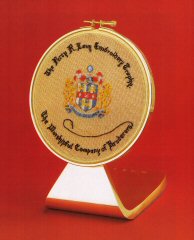Art of Embroidery
Embroidery has been around almost as long as clothes themselves, with needlework believed to originate in the Orient and Middle East.

Broderers' Coat of Arms
One of the greatest periods was 1250-1350, when ‘English work’, or opus anglicanum, was exported and admired all over Europe. This was viewed as an art form on a par with stained glass, sculpture and architecture.
Opus anglicanum was famed for its fine goldwork, used in expansive backgrounds, skillful use of underside couching and expressive spiral split stitch.
Coinciding with the height of English illuminated manuscripts, artists and manuscript illuminators were probably involved in the designs, mostly for church vestments and furnishings, including diplomatic gifts abroad. Few secular examples have survived.
The labour-intensive pieces, such as the Syon Cope in London's V&A Museum, were created by skilled craftsmen. Records show that women were skilled in the art too. These workshops paid modest wages, funded by merchants and noblemen who took the bulk of the profits.

Details from the Master's gown
During the Middle Ages huge naturalistic embroideries representing historical events also became popular, with many brought by wealthy households. The famous Bayeux Tapestry depicting the 11th century Norman Conquest is an early example – Norman work executed in England. Despite its name, it is actually embroidery. Influenced by Mediterranean countries, English works, dyes and tools gradually became more intricate, with Spanishwork (blackwork), Whitework, Assisiwork and Crewel growing in popularity.
After the 1300s, the Black Death, wars and economic stresses combined to cause a decline in standards, while the Reformation reduced the demand for ecclesiastical works.
Embroidery in Tudor times became more confined to wealthier households, on court dress and home furnishings. Servants were often hired because of their skills with a needle. Popular designs included floral motifs with twining rose stems and other English flowers entangled with birds and butterflies. Many used expensive silk, which had to be imported from the Levant.
Aristocratic ladies hired master designers to make pieces, while they devoted themselves to their handiwork. Mary Queen of Scots is known to have studied in France and had two master designers. The Elisabethan period also saw two splendid silver cups given to the Broderers by two of their most significant members, John Parr and Edmund Harrison.

The Percy Levy Trophy
During the 1800s, elaborate freehand stitched thread embroidery began to dwindle as machine embroidery developed. A cruder canvas thread hand embroidery method, known as Berlin woolwork, was popular from 1804. But bead embroidery was thriving alongside techniques for manufacturing smaller beads and fine steel needles.
The Royal School of Art Needlework (now Royal School of Needlework), devoted to hand embroidery was founded in 1872 and moved to Hampton Court Palace in 1987.
In 1906, 16 former students founded the Embroiderers’ Guild to promote the craft, educate the public and preserve fine works of historical and educational merit. It became a Registered Charity in 1964, during the handicrafts revival of the 1960s and 1970s when more embroidery patterns were produced commercially.
Following in the footsteps of HM Queen Mary and the late HRH Princess Alice the Duchess of Gloucester, HRH the Duchess of Gloucester became the Guild’s Royal Patron in 2005. Also residing at Hampton Court, it now has over 25,000 members in the UK and abroad, keeping the old traditions and techniques alive.
